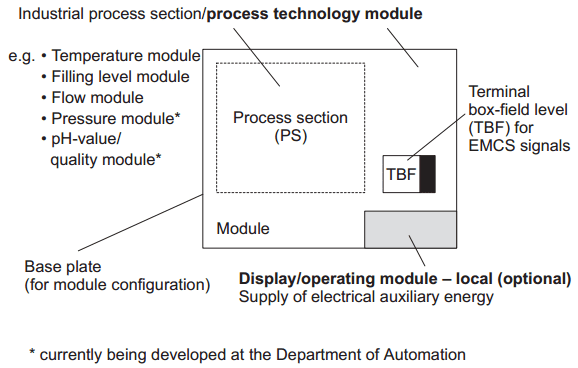Based on the fact that currently engineering training in the field of automation technology is principally dominated by the theory of open and closed loop control, the main purpose of this training concept is to provide would-be practical automation specialists with a sound knowledge of automation methods and project design methods for automation systems. In the sense of holistic training this means that training matters such as the selection and sizing of automation equipment, project design methods, information, electrotechnology, as well as open and closed loop theory must always be taught within a joint context, demonstrated through relevant, practical examples and consolidated by means of practical exercises (learning by doing).
Configuring a small-scale experimental module
Adopting the idea of automating process technology operations as a starting point, the first important point is the question regarding process parameters. By evaluating the experiences gained, typical process parameters such as filling level, throughput, pressure, temperature and quality (pH value) have been incorporated into suitable modules (process technology modules) based on the well-known MPS concept. This means that these modules represent individual process sections and are designed according to a standard structure (Picture 1).
Picture 1: Design of a process technology module
As such, the modules filling level, throughput, pressure, temperature and quality are available for individual use, but can also be combined or duplicated via a central EMCS (Electronic Measuring Control System) terminal and operated as a complex process technology system (Picture 2).
Picture 2: Configuration of the process technology modules
Overview of project design procedure
As already mentioned, the holistic training concept requires the teaching of a sound knowledge of the different training contents typical of automation technology, plus their integration into an effective project design methodology. Picture 3 provides an initial clarification of the extent and technical diversity of the exercises to be completed.
Picture 3: Overview of extent and technical diversity of the basic knowledge involved in the project design of automation systems
The broad knowledge base required for this can only be mastered and put to effective use for project design work by means of a systematic approach (project design know-how). From this viewpoint alone, the small-scale trial station represents an important auxiliary means for the tuition of the necessary training contents and for the development of the required technical and practical competence by means of systematically applying the "learning by doing" concept.
If you now set the task of working through a project design task using the example of this small-scale trial station or an industrial installation in process technology, the project design know-how forms the crucial basis for this. Picture 4 therefore provides an initial introduction of the scope and sequence of the actual project design work in the form of an overview.
Picture 4: Sequence and content of project design work
The starting point of every automation project are the project requirements, which are placed on the automation system. Generally, an invitation to tender is drawn up by the customer for this which, in the sense of the traditional DIN interpretation is characterised by the specification and process flow diagram. The contractor, as a rule the project design company, draws up a proposal (including quotation) and documents the project design work (specification) to be completed via a so-called configurational draft in the form of the PI flow diagram (piping and installation flow diagram).
These tasks are drawn up in the form of a complete set of project documentation by means of the preliminary EMCS block diagrams (electronic measuring control system block diagram) and the final draft (final EMCS block diagrams/wiring lists). The subsequent assembly project design also forms part of the project design task and ensures the assembly of the automation system in the sense of the desired performance range. Finally, some additional tasks need to be fulfilled for the commissioning of this automation system (e.g. specifications for the controller configuration and parameterisation), which form an essential component part of this overall project. Of parallel importance to the project design of this EMCS part, is the implementation of the electrical and the pneumatic and hydraulic project. Picture 4 provides a schematic illustration of the interaction of these three project components.
The core project design now provides a methodology, which sets out the systematic preparation of this broad spectrum of tasks (the core project), and at the same time the linking up with the additional project design tasks (electrical project / pneumatic and hydraulic project). In summary of Picture 4, the core project design (the core project) also encompasses the allocation of the specification, the PI flow diagram and list of EMCS points, the EMCS preliminary block diagrams with the so-called fittings lists and allocation lists, including wiring lists. Moreover, the components System Assembly and Commissioning of the automation system are identified.




Thanks for putting your best efforts in bringing such quality post here. moonhubai
ReplyDelete